Persian lamb & aubergine stew
Khoresh Bademjan (Persian Lamb & Aubergine Casserole)

COOKING WITH AROMATIC HERBS & SPICES

Persian lamb & aubergine stew


This recipe is pure summer on a plate! A light and easy meal – I often cook it the night before we want to eat it and store it in the fridge. It can be eaten warm or cold and it is a great way to get a hit of goodness into you.
Kuku (also spelled ‘kookoo’) is an egg-based, vegetarian dish from Iran made with beaten eggs, folding in various ingredients. It is similar to the Italian frittata, the French quiche or an open-faced omelette, but it typically has more vegetables than its Western counterparts. It is served either hot or cold as a starter, side dish or a main course, and is accompanied with bread and either yogurt, salad and / or rice.
The two most well known kuku recipes are Kuku Sabzi (made with herbs and barberries and / or walnuts); and Kuku Sibzamini (made with potatoes). Ultimately, you can make kuku with any vegetables you like.
This kuku recipe materialised after an Oddbox delivery. Oddbox is a wonderful company that rescues surplus or imperfect vegetables and fruit, which would otherwise not make it to the shopper, and offers it by way of a home delivery subscription services. It’s a fantastic initiative that helps me to eat more vegetables and fruit, while helping to save our planet. It is also been great for challenging my recipe ideas as sometimes I can fall into the routine of buying the same ingredients and cooking the same recipes.
One of my Oddbox deliveries had some kale and red peppers, which lead me down the path of experimenting with the medium of kuku. Kale has become very popular in the UK due to the health benefits. Our supermarkets are always well-stocked with kale and red peppers, potatoes and red onions – the vegetables used to cook this dish. I use garlic, smoked paprika and chillies for the aromatic notes, which results in a smoky and gently warming feel to eating this even when eaten cold.
Traditionally kuku is fried and flipped over to brown on the other side, but I prefer to oven bake mine so the recipe below is geared towards baking but feel free to fry it if you prefer, either omelette-style or like fritters.

The beauty of kuku is that you can make a batch one evening and have it as a quick lunch on your working days. It is also a well-loved addition to a mezze-style meal or served with bowls filled with lots of antipasti.
I have paired this kuku recipe with a pea, mint and feta dip, making the overall experience fresh, light and summery.

Persian lamb patties
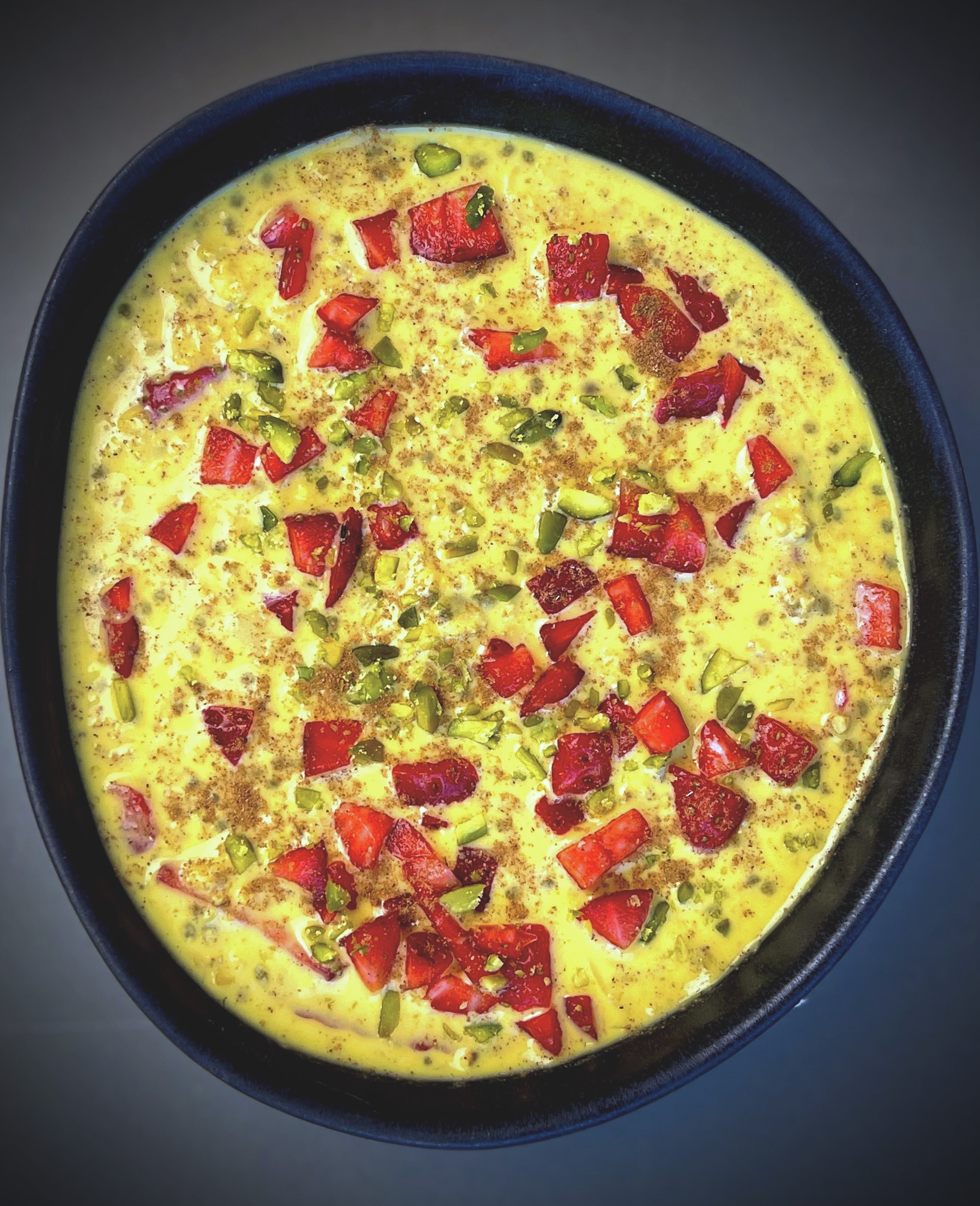

Sholeh Zard is a Persian rice pudding dessert flavoured with saffron, rose water, sugar and decorated with almonds, pistachio and cinnamon. It is a delicious and comforting dessert and loved by Iranians.
After a light bulb moment, I decided to experiment with the flavours of Sholeh Zard with the concept of overnight oats. Overnight oats have become very popular over the last decade. A quick, healthy and delicious way of preparing rolled oats. With no cooking required, it is prepared by mixing rolled oats, liquids and other ingredients and leaving them in the fridge overnight.
The process is simple. Soak oats and chia seeds in milk, Greek yogurt, saffron, rose water and honey. Leave in the fridge overnight. Add flaked almonds and some strawberries the next day and give it a good stir. Serve it in a bowl topped with more strawberries, crushed pistachios and a sprinkle of cinnamon. The resulting breakfast dish is fresh, light and delicious. My family love it and it is one of our regular breakfast options. It’s so low maintenance to knock up and washing up is easier than the mess cooked porridge creates!
I have included chia seeds in the recipe due to the nutritional benefits including adding fibre and protein. Feel free to leave them out if you are not a fan. You can also make this with non-dairy milk and yogurt and replace the honey with maple syrup if you are vegan. If you would prefer to substitute the honey / maple syrup with a wholesome way to sweeten the oats, then grate pear or apple into the oat mixture prior to leaving in the fridge overnight.


This dish is synonymous with Norooz – Persian New Year. Rice is steamed with saffron, garlic and chopped herbs. It is usually served with fish and Kuku Sabzi (a herb and egg frittata).
In Persian, ‘Sabzi‘ refers to herbs or vegetables; ‘Polo‘ refers to the fact that the rice is cooked with another element mixed in, in this case the fresh herbs. The herbs used in Sabzi Polo vary, but typically include dill, coriander, parsley, Persian chives or the green ends of spring onions and in some cases fenugreek.
Iranians traditionally eat Sabzi Polo with a fried or smoked ‘mahi sefid’ (‘white fish’, the Caspian kutum or Caspian white fish which inhabits the Caspian Sea). It’s usually served with pickled garlic, other traditional pickles, Salad Shirazi and ‘Naranj’ – a tart and slightly bitter orange, which we squeeze over the fish and rice like a lemon adding a citrus note to the dish. You can buy Naranj from your local Middle-Eastern supermarket. Sainsbury’s also stock Naranj (bitter Seville marmalade oranges) during the season. Kuku Sabzi is also served alongside the rice on the day, a great alternative should fish not be your thing.
Below is my family recipe for Sabzi Polo. We tend to use a greater amount of fresh herbs compared to others. The herbs use in this recipe are fresh coriander, parsley and dill. In Iran chives are also used but the chives available in the UK are not as spicy so we replace these with the green ends of spring onions. The herbs and greens are mixed in while the rice is parboiling. After draining the rice, it is steamed with garlic butter drizzled over with a little saffron to add further aromatics to this dish.
The accompanying fish is grilled salmon marinated in a simple saffron, honey, garlic, lemon juice, olive oil infusion and smoked sea salt. You can make the Sabzi Polo with any fish you want, including smoked fish like many in Iran will eat on the day. You can pan fry, BBQ, grill, oven bake, poach or steam your fish if you prefer.
Due to the herbs, the tahdig (crispy rice formed at the bottom of the pot) will come out a dark green-brown as you can see in the first picture so do not panic when you flip the crispy stuff out – it’s meant to be that dark!
However, should you prefer you can prepare the dish with a saffron layer of Tahdig as you can see in the pictures above and below. All you need to do is parboil the rice without adding the herbs, drain it and then take 2 cups of rice and add to a little saffron water (1/4 teaspoon ground saffron bloomed in 3 tablespoons water). Mix the rice until fully coated and then line the bottom of the pan, following the addition of the oil/butter, as set out at the step entitled ‘Prepare the Tahdig Layer’ below. Then pat it down and layer the cooked rice with the fresh herbs and the garlic butter layer by layer on top.
You can also have potato or bread tahdig as an alternative. Just replace the rice layer with slices of potato or flatbread.
Serve this dish alongside all or one of the following.
Store in an airtight container, once cooled down, and in the fridge. The rice will last up to 5 days. The salmon will last up to 3 days. you can reheat the rice and salmon in a microwave. Or you can reheat the rice in a saucepan. Remember to add a tablespoon or so of water to rehydrate the rice if reheating. The salmon can also be reheated in a medium oven.

Norooz is the day of the vernal equinox and marks the beginning of spring in the Northern Hemisphere. It marks the first day of the first month of the Iranian calendar (Farvardin). The moment the Sun crosses the celestial equator and equalises night and day is calculated exactly every year. Families gather together to observe the rituals. Due to this calculation, the day Persian New Year falls upon can vary but generally it is either on the 20th or 21st March. The Persian name translated means ‘New Day.’
The festivities and rituals we observe are focussed on letting go of the winter and all the negativity that may be associated with it. We look forward to new life, prosperity and have great optimism which is brought by spring and then the summer months.
In the lead up to the the New Year celebrations, many Iranians will undertake a ritual familiar to many – the ‘Spring Clean.’ I always do a major spring clean and this year was no exception. By day 3 into my efforts my house was messier than when I started, but by the end of the process I felt physically and mentally lighter from the purge of the clutter and the deep clean of the house.
The evening of the last Tuesday before Norooz is the night we celebrate Chaharshanbeh Soori – a festival of fire where we gather together and jump over bonfires. The tradition of jumping over the bonfire originates from people believing that the fire would take their problems, sickness and winter pallor and be replaced by energy and warmth, contributing towards their success for the upcoming year. As we jump, we chant the following words: ‘Zardiye man az toh (my pallor to you); Sorkhiye toh az man (your redness to me).’ See my post about Chaharshanbeh Soori and the dish we eat on that day here.

On the day of New Year we will go to one family member’s house and gather together for the turn of the New Year. We gather around the Sofreh Haft-Seen, a table or other surface, which is set with the symbols of Persian New Year and await the exact moment of the March equinox to celebrate the New Year (even if it happens at 3 am in the morning for some Persian families).
Traditionally, the Haft-Seen (seven things beginning with the letter ‘س‘ pronounced ‘seen’) are:
The Haft-Seen may also include a mirror (self-reflection), candles (enlightenment), eggs (fertility), goldfish (progress), coins (wealth), hyacinth (spring’s arrival), and traditional confectioneries. A “book of wisdom” such as the Quran (religious text of Islam), or the Book of Kings – the Shanameh of Ferdowsi (an epic and long poem on the Persian Empire), or the Divān of Hafez (an anthology of the famous Iranian poet Hafez’s poems) may also be included.
Music will play and we will eat Sabzi Polo ba Mahi and Kuku Sabzi. Many of us continue the celebrations by having a separate organised event for the wider family and friends at a hotel or restaurant where we dress up and dance the night away.
During the Norooz holidays, we make short visits to the homes of family and friends. Typically, young people will visit their elders first. Visitors are offered tea and pastries, cookies, fresh and dried fruits and mixed nuts or other snacks. Gifts are given from the elders to the younger members of the family.
On the 13th day of the Norooz celebrations we celebrate Sizdah Bedar. Iranians spend the day outdoors. Many will go out for a family picnic in a local park. Come rain or shine we will gather outdoors and celebrate this day – throwing our sabzeh into a nearby river or stream marking the end the Persian New Year celebrations.


Although we have translated this dish to be described as a soup, Persian ash (pronounced ‘aash’) recipes tend to be a hearty bowl of goodness. Ash Reshteh is no exception to the rule. A wholesome bowl packed full of Persian noodles (‘reshteh’), kidney beans, chickpeas, green lentils, cooked with fresh herbs and greens and flavoured with kashk (a fermented / preserved food made with the whey left over from cheese-making). The texture of this ash is less soup and more like a chilli.
My version of this recipe differs to my maman’s recipe. I don’t use flour to thicken my ash. I also use slightly more herbs than her. The resulting ash feels fresher and lighter than the traditional recipe / method. If you cannot get your hands on Persian noodles, the closest alternative are udon noodles. You can also use spaghetti or linguine. If you are vegan, leave the kashk out and add some freshly squeezed lemon or lime juice to taste. You can also use a dairy-free yoghurt in addition to the fresh citrus.
This dish is served during the winter time and at special Iranian events like Chaharshanbeh Soori; and Sizdah Bedar. The noodles in the ash are supposed to symbolize good fortune for the new year.
See my next post which is about Norooz and the dish Sabzi Polo ba Mahi (rice layered with herbs and served with fish) which we Persians eat on the day. This post focusses on Chaharshanbeh Soori and Sizdah Bedar, when my family come together to celebrate and eat Ash Reshteh.
The first event in our Norooz festivities takes place on the evening of the last Tuesday before Persian New Year. It is a Festival of Fire. People in all parts of Iran and those of us who live outside of Iran celebrate this festival by setting up bonfires in almost all the public places in Iran – in our gardens or at organised events for the diaspora community.
We eat Ash Reshteh and other Persian delights and jump over the bonfires. The tradition of jumping over a bonfire originates from people believing that the fire would take their problems, sickness and winter pallor and be replaced by energy and warmth, contributing towards their success for the upcoming year. Therefore, jumping over fire on Chaharshanbeh Soori night is like a purification rite or a phrase familiar to the West ‘out with old, in with the new.’
As we jump, we chant the following words: ‘Zardiye man az toh (my pallor to you); Sorkhiye toh az man (your redness to me).’

Another tradition is to bang on pots and pans with spoons that are named as ‘Ghashogh Zani,’ with the objective of beating out the last Wednesday of the year.
It is a celebration of good health and light – the end of winter and the beginning of Spring. It is believed that the ritual guarantees the dissipation of the misfortunes and evils and the materialization of hopes and desires for the next year.
Sizdah Bedar is considered the final day of the Persian new year celebration. It is celebrated on the thirteenth day of Norooz. The festival’s name translated means ‘getting rid of the thirteenth.’ As with many cultures, the number 13 was considered bad luck by Iranians and so they believed that by being outside with nature the bad luck would dissipate. Therefore, on Sizdah Bedar, Iranians spend the day outdoors. Many will go out for a family picnic in a local park. One family member will be entrusted with bringing a pot of Ash Reshteh and the rest of us the sandwiches and other Persian treats!
Come rain or shine we will gather outdoors and celebrate this day – throwing our sabzeh (sprouted lentils or wheat and one of the symbols of Norooz representing rejuvenation and new life) into a nearby river or stream. Other than eating, another ritual for the day is knotting greens. Usually, the young unmarried people knot the green of the sabzeh to find their soulmate prior to throwing it into the water.
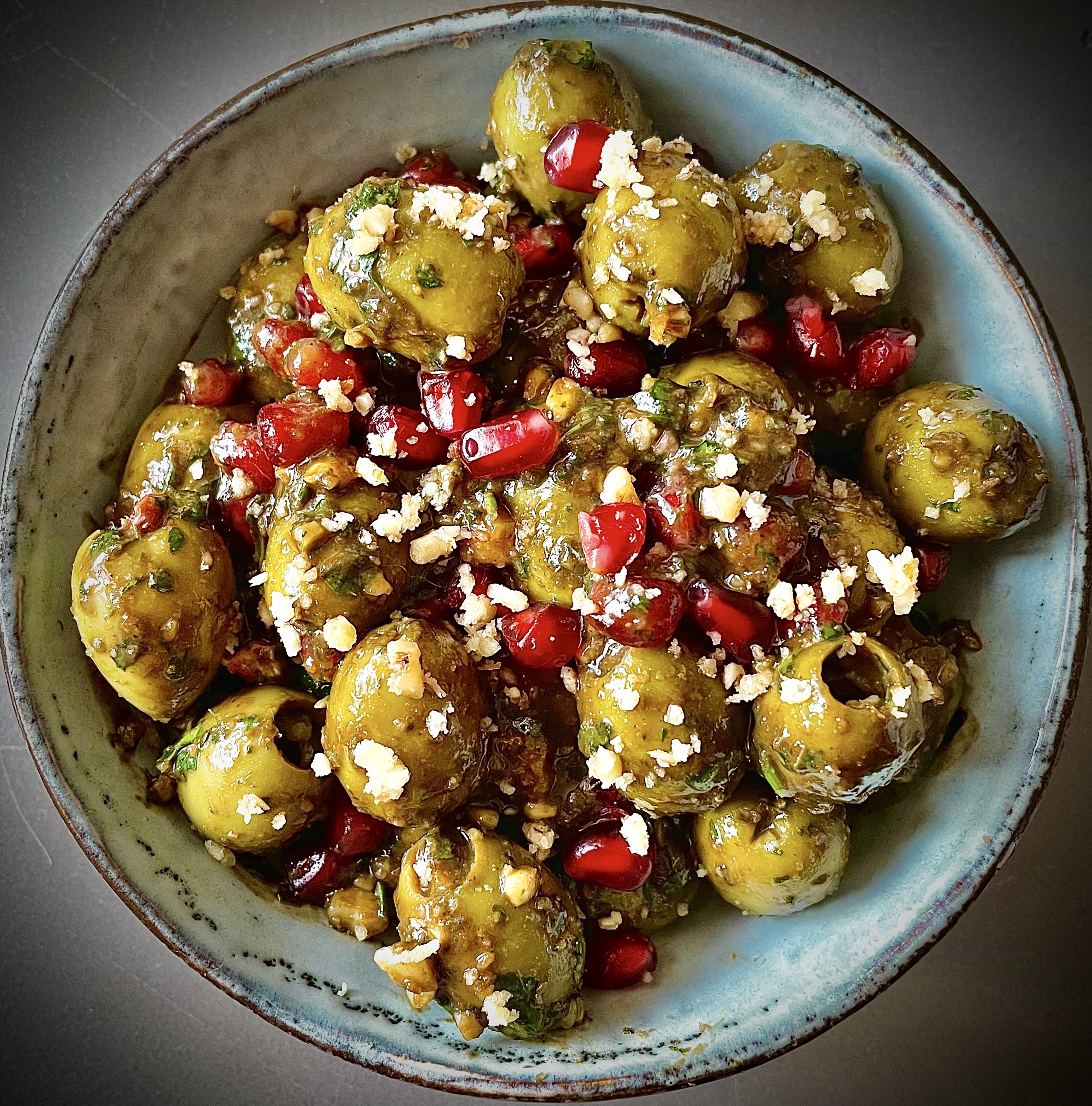

This delightful appetiser heralds from Gilan Province in the North of Iran, a region I visited in my mid twenties and one my family has become more familiar with over the last 20 years. Gilan Province lies along the Caspian Sea bordering Russia. The Province is lush and green with many delicious dishes, particularly vegetarian, originating from the Province, including Mirza Ghasemi (smoked aubergines and eggs) and Baghali Ghatogh (eggs with broad beans and dill).
The North of Iran loves walnuts and pomegranates and a number of their dishes use this combination including Zeytoon Parvardeh.
The ingredients are olives; pomegranate juice, molasses and arils; walnuts; garlic; and a herb called chuchagh. Chuchagh is a rare herb and is found in certain areas In Iran. In order to emulate its flavour for this dish we replace it with mint in the UK. I have also added a bit of coriander and parsley to my recipe.
I use large pitted green olives like gordal or karyatis olives. By using pitted olives, it allows for the marinade to seep into the olives and also makes it easier to eat them.T he flavour profile of this dish is sweet and sour and incredibly moreish.
It is an easy and quick dish to prepare and ideally made the night before so that the flavours blend and intensify. I often make a small bowl of this appetiser and slowly work my way through it with cheese and crackers – I hasten to add that eating it as an accompaniment with cheese is not authentically Iranian but it works!
Zeytoon Parvardeh can be eaten with pre-dinner drinks (wine, cocktails or hard liquor – whatever you fancy), as part of a mezze-style platter or array of dishes, or with cheese and crackers which is my favourite way to eat it.


This dish literally translates as ‘kashk and aubergine.’ It is a dip make with aubergine, which is cooked and flavoured with turmeric, onion and lots of garlic. Kashk is mixed through to give a slightly tart and creamy flavour. The dip is then topped with mint oil, kashk, crushed walnuts and cispy onions. It is a unique tasting dip with its rich and earthy tones.
Kashk is a range of fermented dairy products used in Iranian, Turkish, Balkan and Arab cuisines. Kashk has been a staple in the Persian diet for thousands of years.
Persian “kashk” is a fermented / preserved food that comes in liquid or dried form. It is traditionally made with the whey left over from cheese-making. It is used in dishes like Ash Reshteh (a herb, lentil, bean and noodle soup) and Kaleh Joosh (a soup made with walnuts, onions and mint). In its dried form it needs to be soaked and softened before it can be used in cooking.
The taste of kashk is distinctive and almost indescribable. It is well worth purchasing and not substituting with an alternative, such as yoghurt. Kashk provides a sour, salty, creamy and slightly cheesy flavour to the dishes it is added to.

When I was growing up, my maman used dried balls of kashk which she would soak in a bowl before adding it to a recipe. Apparently before she knew she was pregnant with my sister, a relative surmised she was as she saw her sucking on kashk like they were sweets! Nowadays, you can buy kashk in liquid form in jars from Middle-Eastern food shops or online. I use Kambiz Kashk and buy it online here or by popping into a local Middle-Eastern supermarket.
I fry the aubergines, as do most Iranians when they cook this dish. But you can oven roast the aubergine, if you prefer. Brush them with a little oil and roast for 30 – 40 minutes or until they are cooked through and soft (oven temp – 180°C (fan) / 200°C (conventional) / Gas Mark 6). If you roast your aubergine, you will need to add a little oil to your frying pan to cook the garlic step 5 and 6 below).
In our family we tend to serve it as a starter with flatbread at our larger family gatherings. At home, as a family of 3, we eat it as a main course with a hearty salad like tabbouleh, Nan-e Barbari (Persian Flatbread) and some fruit for afters as pictured.
Check out these other great dip recipes.
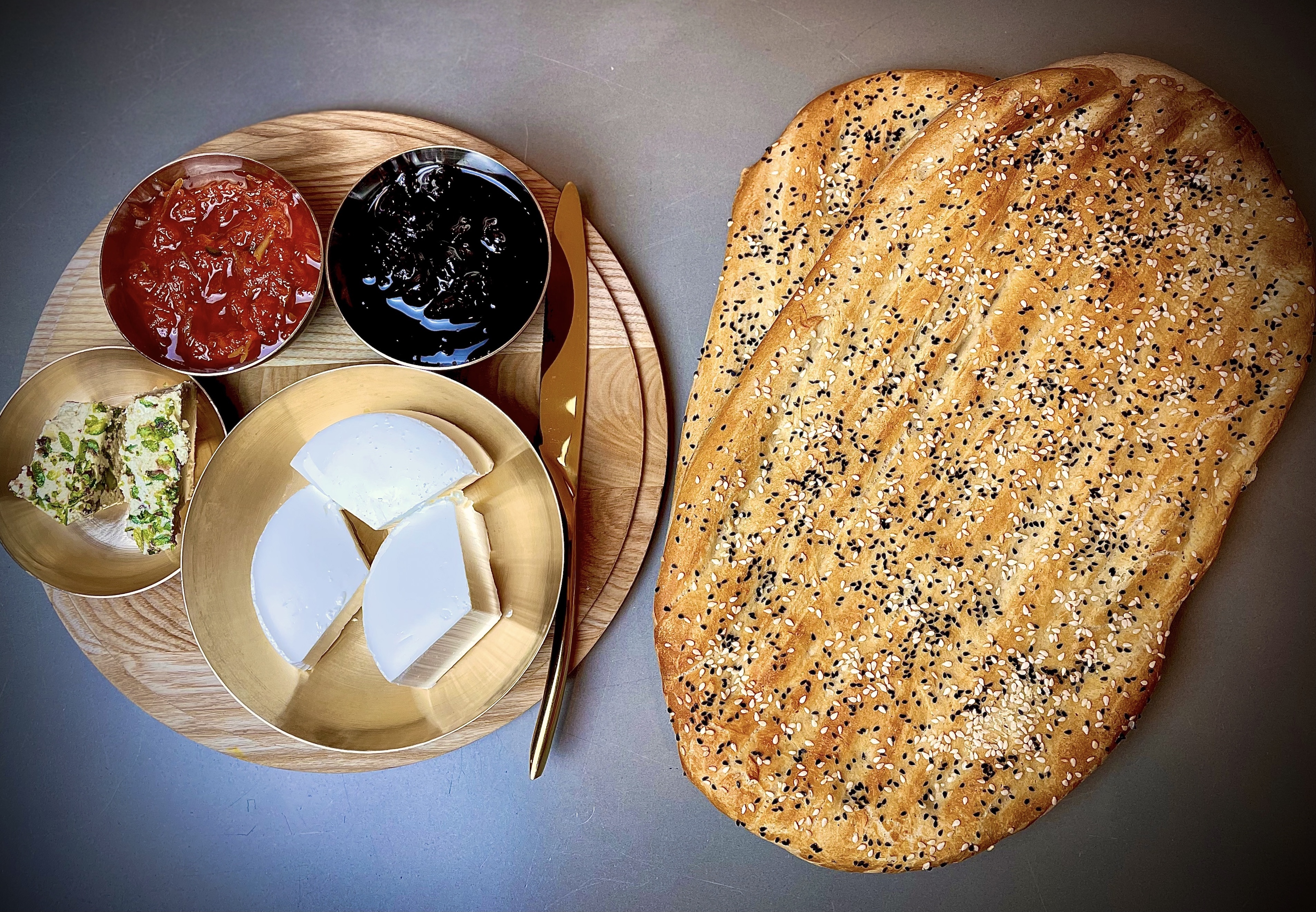
Persian flatbread with nigella and sesame seeds


This recipe is an adaptation of the dish ‘Estamboli Polo.’ A rice dish that comes in many different iterations. Some do a vegetarian version. Others include meat. Some include green beans. Some don’t use potatoes. My version is a vegetarian version with onions, potatoes and tomatoes layered through the rice. In addition, as found in most Persian cooking, turmeric and saffron provide the rich flavour to this rice dish. I have added some extras to my version including garlic, parsley and coriander for extra flavour.
I wanted a quick version of this dish for my family. Instead of using the traditional method of cooking Estamboli Polo by draining the rice after par-boiling, I used the kateh method. Simply boiling and steaming the rice without draining the water. The resulting rice is delicious, quick and involves less washing up. Also it still creates tahdig – the crispy rice at the bottom of the pot.
Perfect when accompanied with a salad like Salad Shirazi, or Maast O’Khiar (Persian yoghurt, mint and cucumber dip), or torshi and/or fried eggs.
Make sure the rice has completely cooled down, then store in an airtight container in the fridge up to 5 days.


Borani is an Iranian appetiser, which is a dip made with yoghurt. The most well-know of these dips are Borani Esfenaj (spinach, garlic and yoghurt dip) and Borani Laboo. But you can make borani with any vegetable you want including roasted aubergines and courgettes.
This dip is made using cooked beetroot, Greek yoghurt, garlic, nigella seeds, dried mint, feta, toasted argan oil and red wine vinegar. My go-to Greek Yoghurt is Total by Fage – 5%. It is thick and creamy which is perfect for Persian dips.
Beetroot is of exceptional nutritional value with it being an excellent source of folic acid and a very good source of fibre, manganese and potassium. But it can taste too earthy to some or as my husband puts it – ‘It’s like eating soil.’ In fact, beetroot isn’t the most loved vegetable in my family unless I make it into this dip. Then it gets devoured at a rate of knots with me barely getting a look in! The combination of ingredients brings out the best in beetroot.
I recommend buying raw beetroot and boiling them yourself. But if you do want to use pre-boiled ones then avoid the ones cooked in vinegar. Otherwise your borani will be too tart. You can make a vegan version by substituting the yoghurt and feta below with a plant-based alternative.
The recipe for Borani Laboo below is an add-on recipe to my Kuku Sabzi post (seen pictured around the borani dip bowl). You can, of course, make and eat this dip without Kuku Sabzi. It is delicious with crisps or flatbread and makes a great addition to a mezze-style meal. The colour of the borani is stunning and has an eye-catching presence on your table of appetisers or other Persian delights.
Keep leftovers in an airtight container in the fridge and this dip can last up to 5 days.
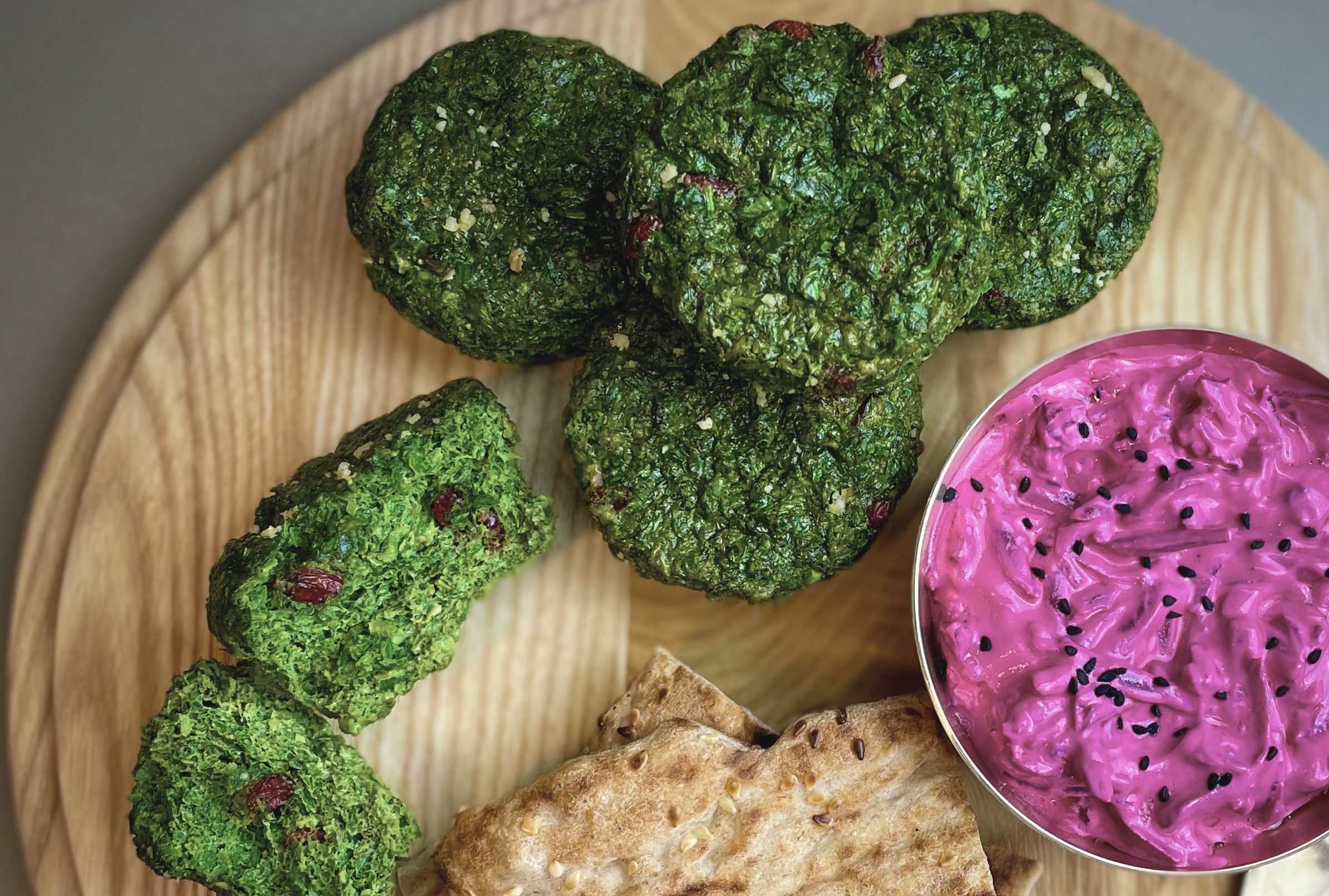

Kuku Sabzi is a frittata-style dish traditionally made with eggs, turmeric, coriander, parsley, dill, chives, barberries and crushed walnuts. It is usually fried and then sliced into triangles. You can serve it either hot or cold as a starter, side dish or a main course. It can be accompanied with bread or rice and either yogurt or salad.
The key difference between a kuku and a frittata is the egg to vegetable ratio, with the kuku favouring the latter.
Kuku Sabzi is eaten during the celebrations for Persian New Year (‘Norooz’). Norooz is the day of the vernal equinox, and marks the beginning of spring in the Northern Hemisphere. It usually falls on 21 March each year. This festival dates back over 3000 years and is rooted in the ancient Persian religion of Zoroastrianism.
It is estimated that Norooz is celebrated by over 300 million people including communities in Afghanistan, the Kurdish regions of Iraq and Turkey, Parsis in India, and their related diaspora around the world.
The herbs in Kuku Sabzi symbolise rebirth, and the eggs symbolise fertility. We serve it alongside Sabzi Polo ba Mahi (Persian herbed rice and fish).
As with the traditional recipe, dried barberries are added to the kuku mixture. This gives a tart burst of flavour from the berries with each bite. You can buy barberries from most Middle-Eastern food shops or, alternatively, buy them online. I also add coarsely ground walnuts to the mixture to give a little crunch to the kuku.
To prepare the herbs, wash them and remove the toughest parts of the stems. There is no need to remove all the leaves from all the stems if you have a food-processor to chop the herbs finely for you. Dill and parsley will require a bit more time removing the tough stems unlike coriander which you can usually chuck in and blitz.
Silicon baking moulds are excellent for baking kuku but if you don’t have any, use a standard muffin tin but make sure you grease and line it properly.
Serve alongside vibrant Beetroot Borani (yoghurt and beetroot dip) as pictured. You can find the recipe for this delicious dip here.
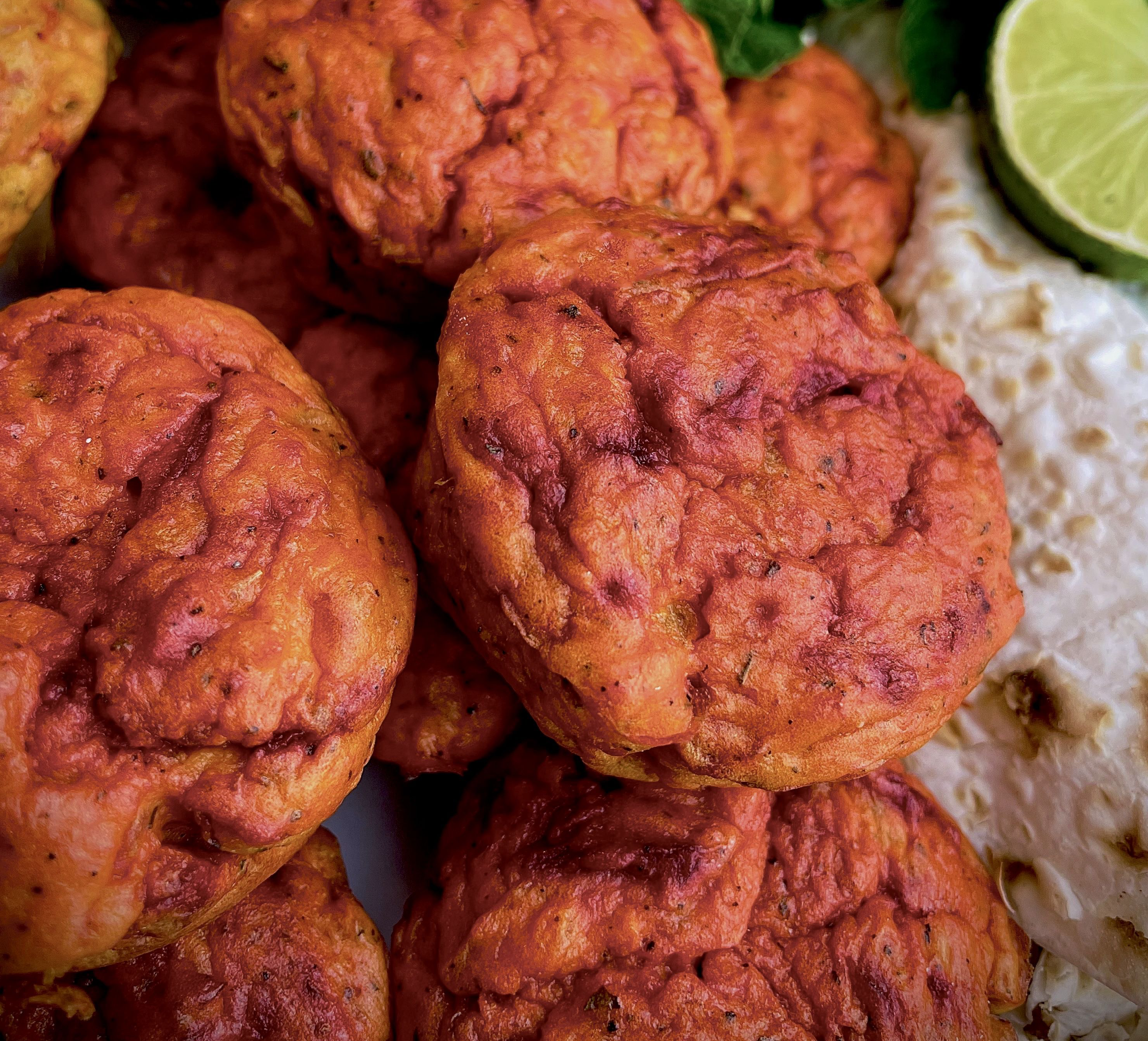

Kuku is a Persian frittata-style dish. Usually vegetarian, it is made with beaten eggs, herbs or vegetables folded in. The main difference between kuku and its western counterparts is the ratio of egg to vegetables, with kuku favouring the latter.
The two most well known kuku recipes are Kuku Sabzi (made with herbs, barberries and walnuts); and Kuku Sibzamini (made with potatoes). We also have Kuku Kadoo (made with courgettes). There are no hard and fast rules about what you should put in your kuku. I have made ones with curried mushrooms; kale and red pepper; cheese and tomatoes; and the list goes on.
The traditional Kuku Sibzamini recipe is made using mashed potatoes, grated onion, turmeric, saffron, dried mint and egg. The mixture is then made into patties and fried.
This recipe is my variation to Kuku Sibzamini. I have added beetroot, garlic and feta to the recipe. The resulting kuku has a vibrant colour and delicious depth to the flavour. I also bake the kuku instead of frying.
Always use fresh and good quality ingredients. Make sure the feta you use is block feta in brine and not crumbled. My favourite brand is Aytac.
It is a great addition to a mezze platter or a sandwich filler. You can serve it either hot or cold; as a starter, side dish or a main course. Serve kuku with flatbread, yoghurt and/or salad. The picture below is one of our kuku platters.



Chicken is slow-cooked in a saffron and turmeric-infused sauce with apricots, sour plums and quince to give an amazing sweet and sour flavour.
This khoresh (stew) is not as well-known as other stews from Iran such as Ghormeh Sabzi (lamb stew with herbs and dried limes) or Fesenjoon (chicken stew with pomegranate molasses and walnuts). This is probably due to the hero ingredient of the stew – quince. Quince is in season between October and January in the UK and during these months I suspect most Iranian households (like my family) will try to cook this dish a few times before the season ends.
Quince is the fruit from a deciduous tree. It has a similar appearance to a pear but the fruit is generally not eaten raw but processed. Many of you may be familiar with quince being used to flavour gin, eaten as a paste with cheese or made into jam.
For those of you new to quince, let me tell you about this lovely fruit. It is a member of the apple and pear family. It has a yellow, lumpy hard flesh with a bitter flavour when raw. Due to the unpalatable flavour when raw, quince is generally consumed after cooking. When cooked, quince becomes soft and dense and develops a sweet, slightly tart flavour with hints of apple, pear, and citrus. Quince can last up to several weeks if stored in a fridge.
The best quince is grown in Esfahan in Iran and unsurprisingly the dish originates from this beautiful city. There are a few variations of this khoresh with some cooking it with lamb; using tomato purée; adding lentils. The recipe I have shared below results in a sweet and sour stunning golden stew, an unusual colour by comparison to the other stews we Iranians cook.
This dish is delightfully easy to cook with minimal preparation. The final dish is comforting and loved by adults and children alike, so it is a great family recipe.
Serve this khoresh with Chelow (Persian steamed rice) and Salad Shirazi. Alternatively, serve it with a parsley mash and steamed green vegetables or just eat it with crusty bread.



It definitely tops my list of Persian comfort foods, reminding me of my childhood and the big family gatherings my mother would host.
Zereshk polo is Persian steamed rice, layered and/or topped with barberries. It is a sweet and sour dish. The barberries are gently sautéed on a low heat with sugar and bloomed saffron water before being added to the rice.
Where rice dishes are referred to as ‘polo’ (pronounced ‘pawlaw’) it usually indicates that the rice has been mixed with some other ingredient. Our plain white rice, served with our kebabs and khoresh (stews) is referred to as ‘chelow.‘ In the case of this dish, barberries are the additional ingredient.
Barberries are edible red berries which grow in the wild in Europe and West Asia. They are rich in vitamin C and tart in flavour. They are called ‘zereshk’ in Persian and are bought and used in their dried form. You can buy zereshk from most Middle-Eastern food shops or online.
‘Morgh’ means ‘chicken’ in Persian and refers to the accompanying protein served with the rice. It is commonly served with poached saffron chicken or chicken stewed in a saffron sauce and either layered through the rice or on the side. Some Persian restaurants serve it with Jujeh Kabab (grilled chunks of chicken, marinated in onion, lemon juice and saffron). Either way, you must be getting a sense that some kind of saffron flavoured chicken complements this sweet and sour rice dish!

My mother and other members of our family would always poach chicken breast and layer it in the zereshk polo. I appreciate now that, when cooked for too long, this cut of meat can be quite dry. My recipe below uses chicken breast but the cooking method ensures it remains juicy. I generally source chicken from a butcher (online or the old-fashioned method of dropping into a local establishment).
For this recipe I bought chicken breasts with the skin left on and a partial wing (the drumette) in tact. I marinate the chicken overnight, pan fry them and then finish it off in the oven as per the recipe instructions below.
You can also eat this rice with saffron stewed chicken (see picture below). I will post a recipe for this in due course, but for now the recipe below is a homage to the dish I grew up with. The recipe below will also result in the delicious crispy rice formed at the bottom of the pot (tahdig). Tahdig adds a lovely crunchy texture to the dish.
Because of the layer of barberries and saffron rice, the key to serving this dish is to spoon the rice out on to a platter (as seen in the pics). The tahdig is usually served separately as a side dish.

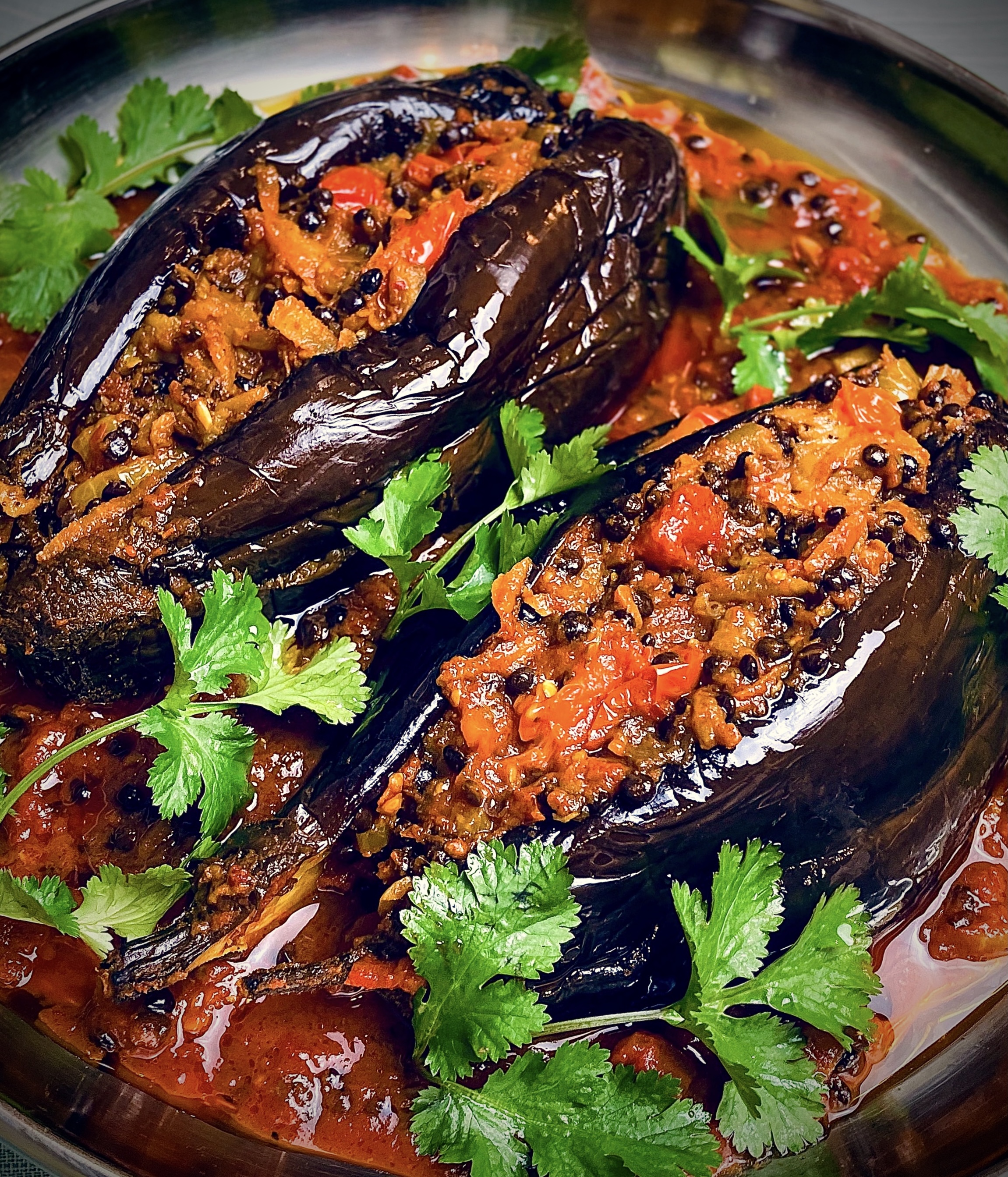

Garni Yarikh comes from the Azerbaijani province of Iran (northwestern Iran bordering Iraq, Turkey, Armenia, and the Republic of Azerbaijan). The region is mostly populated by Azerbaijanis also known as Iranian Azeris, who tend to speak Azerbaijani (a Turkic language) as their first language.
Garni Yarikh translated is ‘torn belly’ with the Persian equivalent being ‘Shekam Pareh’. Traditionally the aubergine is stuffed with a mixture of mince meat and then simmered in a rich and tangy tomato-based sauce. The Turkish version, and where it originates from, is called ‘Karnıyarık.’
The recipe below is a vegan version, as Iranian food can be quite heavy on the meat. Where an opportunity presents itself, I like to adapt a recipe to be plant-based. To make the recipe vegan, I have replaced the mince meat with lentils and added vegetables to the stuffing mixture. You can use any lentils you want. I buy pre-cooked lentils as it reduces the preparation and cooking time.
My go-to lentils for this dish are Merchant Gourmet Beluga Lentils. They absorb the sauce brilliantly and have a lovely texture.
If you have time, I recommend salting and leaving the aubergines for 30 minutes to draw out some of the water. Aubergines can afford to lose a little water pre-cooking but it isn’t an issue if you just want to launch into the recipe as per the steps below.
What to Serve with this Dish
Eat Garni Yarikh with a salad like tabbouleh and hummus on the side. This dish can also be served with rice (kateh or chelow). Also flatbread is a great accompaniment.

This chickpea curry served with parathas and fried eggs is a great addition to your weekend brunch catalogue of recipes. Make this recipe the night before and just re-heat if you want a lie-in and a lazy morning.

My journey to discover more about the cuisine of Iran has led me to Sistan and Baluchestan in the South-East of Iran. It is the second largest province of the 31 provinces of Iran, after Kerman Province.
The province borders Pakistan and Afghanistan and has a population of 2.5 million, which the majority are Baloch. They mainly inhabit mountainous terrains which has allowed them to maintain a distinct cultural identity and resist domination by neighbouring rulers. Approximately 20-25% of the worldwide Baloch population live in Iran. The majority of the Baloch population reside in Pakistan, and a significant number (estimated at 600,000) reside in southern Afghanistan. Baluchestan of Iran has been regarded as the most underdeveloped, desolate, and poorest region of the country.
The food from the Southern Provinces of Iran tends to be spicier. In light of its bordering countries, Sistan and Baluchistan has a cuisine similar to those countries. Street food vendors and restaurants offer a range of dishes from chickpea curry served with fried eggs and parathas for breakfast; to kebabs rubbed with spices referred to as ‘Baluchi Masala’ for dinner. Restaurants in the area also serve karahi (curry-style dishes) and biryanis, whilst also offering an array of traditional Persian dishes.
The recipe below seeks to re-create the breakfast dish of chickpea curry with parathas and fried eggs eaten in the hustle and bustle of Chabahar. The city is situated on the Makran Coast of the Iranian province of Sistan and Baluchestan. It is officially designated as a “Free Trade and Industrial Zone.” The name of the city translated means Four Springs as the climate feels like spring all year round.
Parathas are a type of flatbread commonly eaten in South Asian cuisine. The ingredients are simply plain flour, water, some oil and / or ghee and salt. Gently knead and rest the dough for 30 mins before cooking in a skillet or frying pan. Then butter before serving.
If you don’t want to make the paratha, by all means pop into your local Asian supermarket and purchase some or any other flatbread such as chapatis or roti. I am not a seasoned paratha maker but if you follow the recipe and steps below, the resulting breads are soft, flaky and perfect for dipping into the yolk of your fried egg and scooping up the chickpea curry.
You may have eaten Channa Masala, Channay or Chole before as this curry is known in the Indian subcontinent. As with all aromatic food, the longer you cook/leave it the more intense the flavours. I often prepare the chickpea curry the night before and let it simmer for over an hour to intensify the flavours.
I also make the parathas the night before and just heat them up in a dry frying pan or skillet the next morning so all I am cooking are the eggs on the day we want to eat this meal.
If you are making this dish all in one go, then make the chickpea curry first. While the tomato sauce is simmering (before you add the chickpeas), prepare the paratha dough. Then, after you add the chickpeas to the sauce, just let the curry simmer gently as you roll out and cook the parathas. Fry the eggs as the final stage.
Serve this dish with fresh herbs such as coriander, mint, Thai basil and tarragon alongside the parathas, curry and fried eggs. My family and I often eat this breakfast/brunch dish washed down with a homemade mango lassie or Persian tea.
Breakfast is probably my favourite meal of the day so I invest as much time in it as I would an evening meal. Check out my other breakfast recipes to enjoy for weekend family brunches.
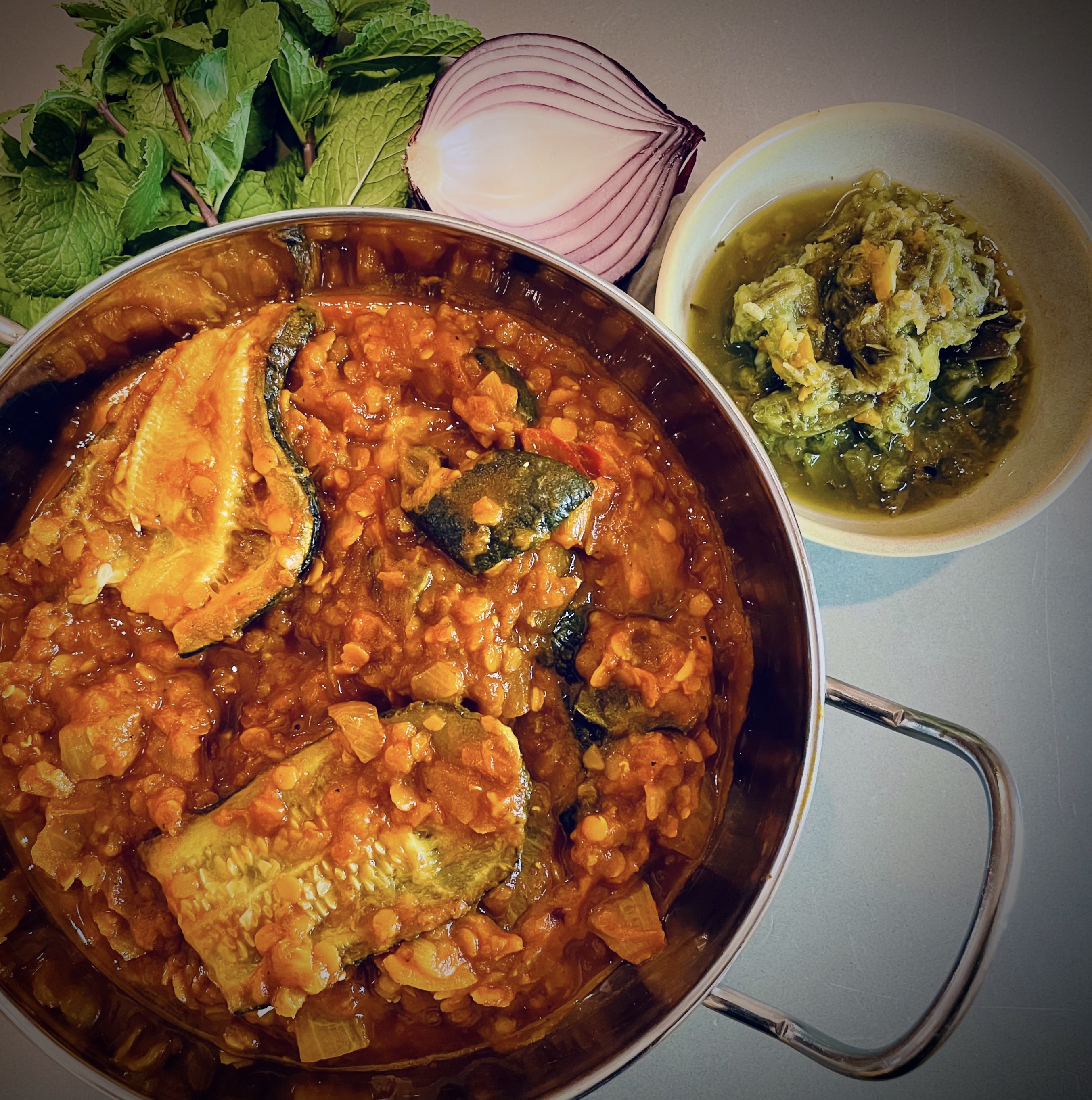
Spicy courgette and red lentil stew
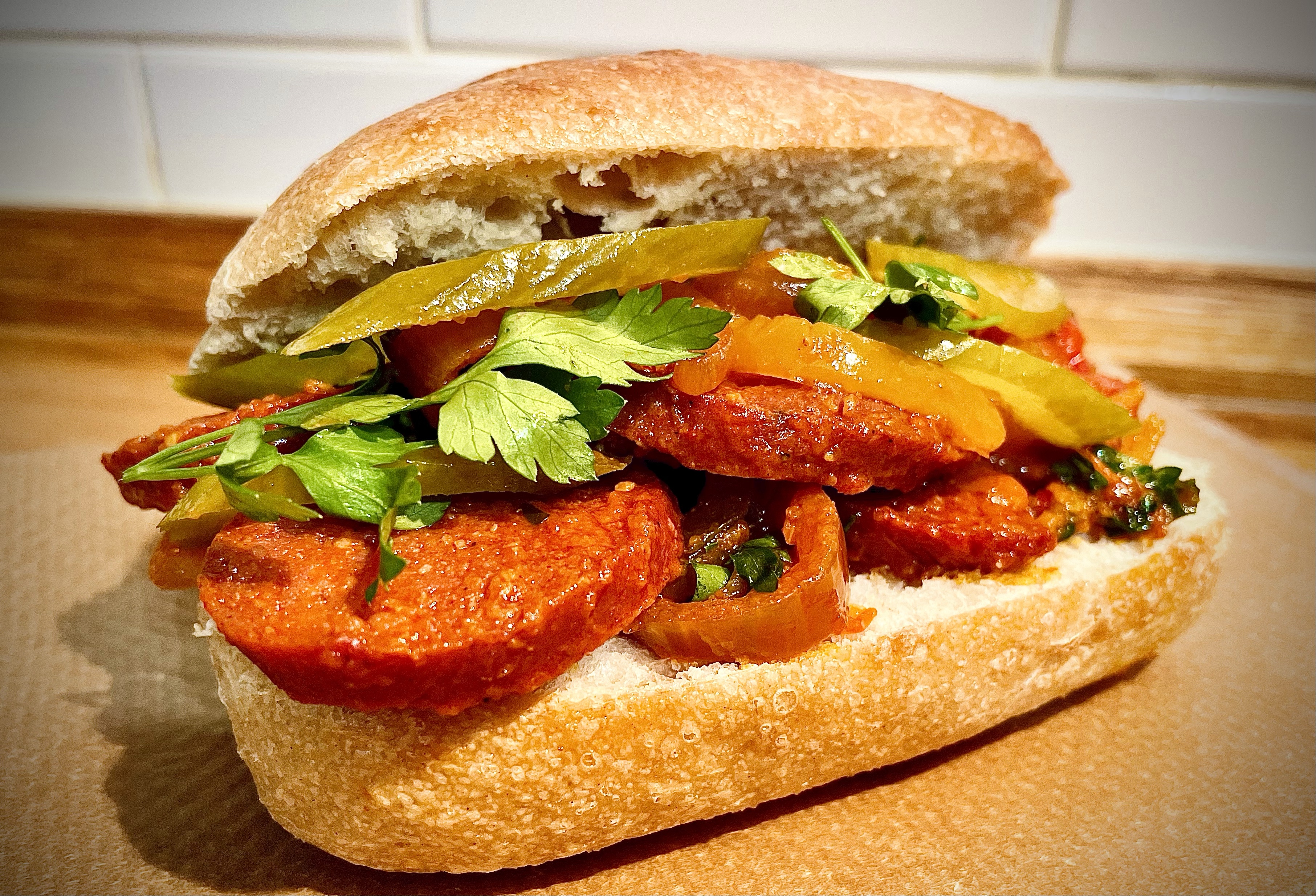

This dish is basically the Persian equivalent of a sausage sandwich! Beef sausages are cooked with onions and peppers in spicy tomato sauce and it is commonly served in a baguette-style bread.
Sosis Bandari translated is sausage from the port or port-style sausage. ‘Sosis’ is the Persian word for sausage, and ‘Bandar’ means port. Apparently this dish was invented in one of the northern ports of Iran, called Bandar Anzali where the first sausages were introduced from Iran (probably from Turkey). However, it became trendy amongst southern port residents, and the dish is now associated with Southern Iran. Iranians who live in the south of Iran mostly eat spicy foods and this dish packs a punch due to their revisions to the original recipe.
I love this dish as it is so easy to cook and, other than the sausage, all other ingredients are available at your local supermarket.
If you are using your local supermarket raw sausages then cook them first (as per the instructions on the packet) before slicing them up and adding to the recipe below.
Traditionally Sosis Bandari includes potatoes in the mixture itself, however my recipe extracts the potatoes and cooks them separately by making them into saffron flavour roasties to be eaten as a side dish and dipped into harissa mayonnaise.

I serve this dish as a sandwich using a rustic roll with a side of saffron roasties. I also love to put pickled cucumbers and some fresh herbs in the Sosis Bandari Sandwich. A cousin of mine recently mooted adding cheese to the sandwich which would also be an excellent addition.
Check out our other recipes:


I first made these cupcakes over 10 years ago for a friend’s wedding and they have been a firm favourite ever since.
I experimented with many flavours but these were the favourite amongst my family. Not surprising really as they are flavoured with rose water and pistachio. Had I found a use for saffron in the recipe, then I would have had the holy trinity of Persian desserts! But I felt the pink and ivory tones were perfect for the cupcakes’ presentation and that the yellow effect of incorporating saffron would not have been as aesthetically pleasing.
Cupcakes enjoyed a lot of attention and glamour following the episode in Sex and the City featuring Magnolia Cupcakes. The UK saw Violet’s Cakes, Hummingbird Bakery and Lola’s Cupcakes as the UK’s representation in the delicious world of luxury cupcakes.
Most people I speak to have baked cupcakes before but even if you are a first-timer, despite how pretty these mini cakes look, they are very easy to create. Many of us have cake-making equipment in our kitchen nowadays, such as electric beaters or stand mixers and if not it’s a great workout for the arms!

My go-to recipe for a basic cake batter is what I call the 4:225 ratio. For 4 eggs, I use a weight of 225 grams for the dry ingredients and butter.
The above are the ingredients for a basic vanilla sponge. I then add other flavours, such as rose for this recipe or lime zest for my cherry and lime flavoured victoria sandwich. This standard cake batter recipe creates a lovely crumb and yields 12 cupcakes in a muffin-style tray or 1 x two layer victoria sandwich (8″ diameter).
For the decoration, I use a standard buttercream icing flavoured with vanilla and rosewater. I use crushed fresh pistachio slivers and edible rose petals, which are both available from Iranian and Middle-Eastern supermarkets. If you cannot get your hands on rose petals, then crushed fresh pistachios are equally lovely for decorating.
Store cupcakes in an airtight container for up to 3 days.
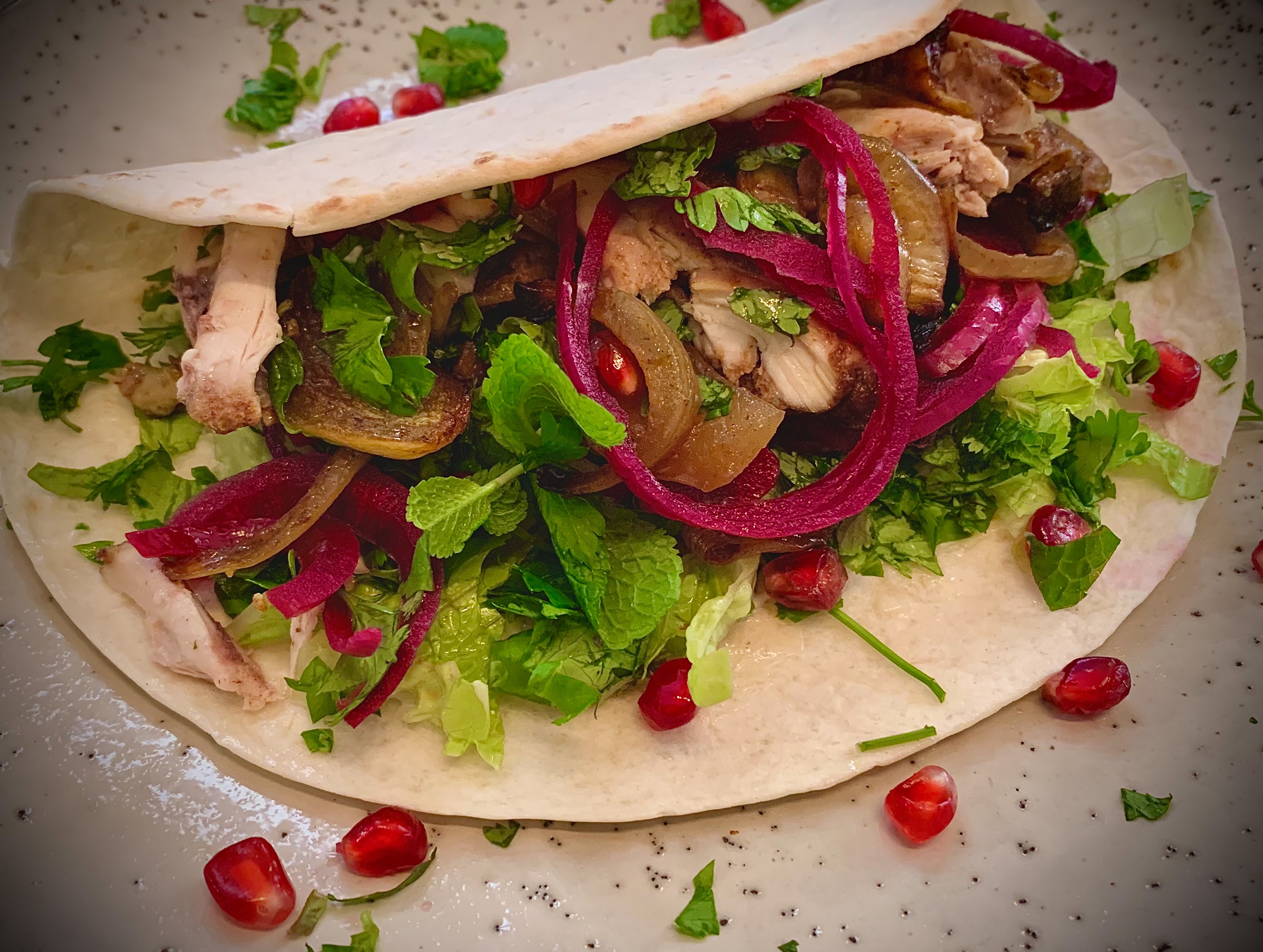

This is an easy recipe and will be familiar territory for you if you have, as most people have these days, cooked and / or eaten some kind of wrap. If not, it is still an easy recipe to follow and worth getting your hands on the two ingredients you may not have to hand – pomegranate molasses and moosir (Persian shallots).

Pomegranate molasses is a thick syrup with a dark grape colour made from reducing pomegranate juice. The juice is obtained from a tart variety of pomegranate. You can pick up pomegranate molasses (rob-e-anar) from most Middle-Eastern food shops, online or even at some local supermarkets.
It is deliciously tart but the addition of maple syrup and freshly squeezed orange juice balances the favours perfectly for this marinade and complements the chicken. As with all marinades, the longer you leave it the better. So if you have time to marinate your chicken overnight (thighs with skin on and bone in preferably) this will allow the chicken to absorb all the delicious flavours.

Moosir is a Persian shallot and has a flavour profile similar to garlic but slightly sweeter and less spicy. They grow wild in the foothills of the Zagros Mountains. They have to be found and dug out of the earth – a similar process to truffles. Commonly used in a yoghurt dip called Maast-o-Moosir, this ingredient adds an amazingly distinctive flavour to dishes. You can buy moosir from most Middle-Eastern food shops or online.
Moosir is bought in its dried form and will need to be rehydrated before use. Soak the moosir in water for 3 to 24 hours. Drain, then rinse in cold water and pat dry. Check the moosir and cut out any stems that remain hard after soaking. I have added the moosir to the mayonnaise for the chicken wraps. Once hydrated, chop the moosir finely and mix with mayonnaise. If you cannot get your hands on this Persian shallot, then you can use garlic. I would recommend steeping the cloves in boiled water before mincing and adding to the mayonnaise to temper the raw garlic.
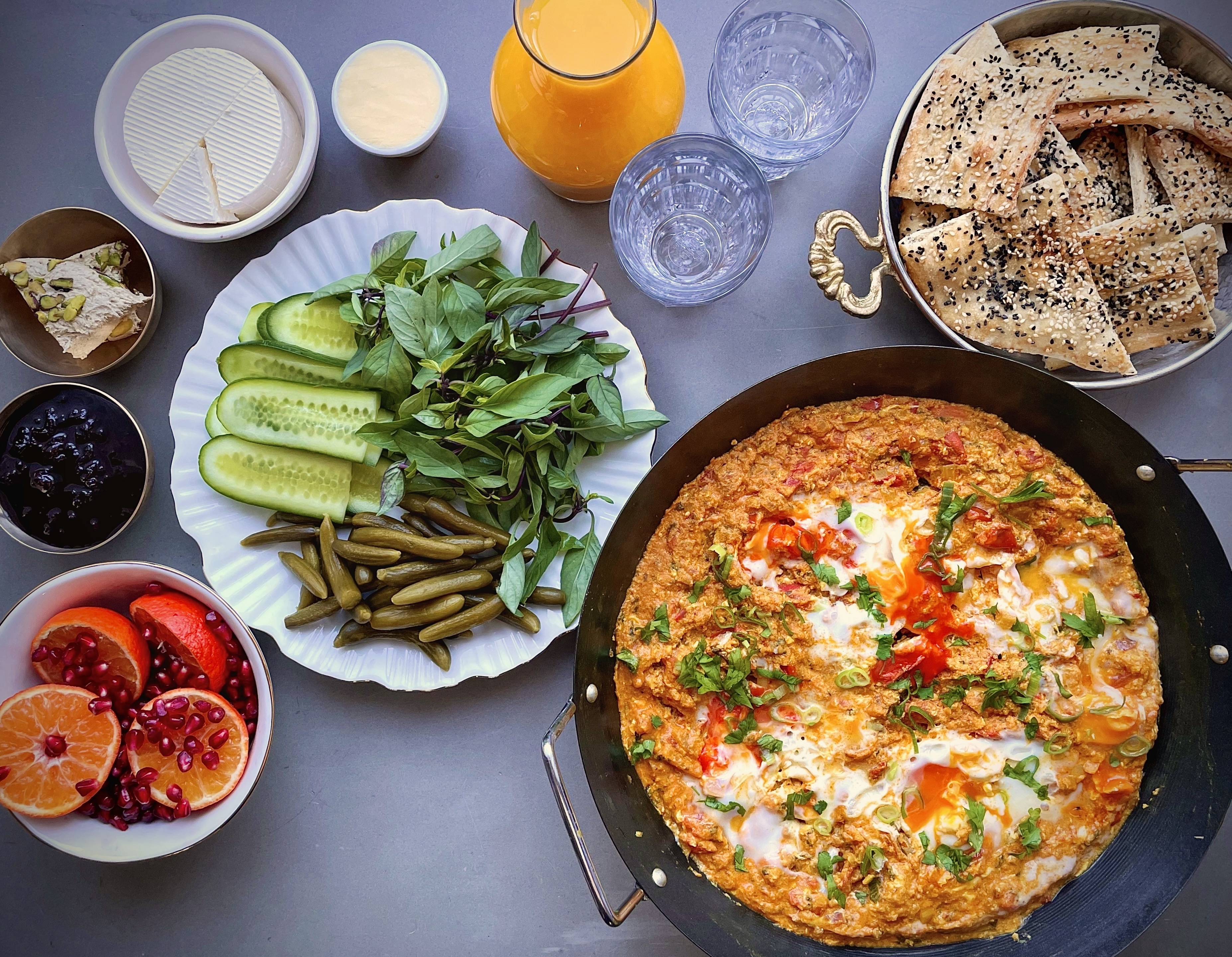

Omelette Gojeh Farangi is made by cooking eggs in a rich tomato sauce. The sauce is flavoured with aromatics and spices – garlic, cumin, turmeric and chilli. The tomato to egg ratio is quite high so the resulting texture is creamy.
It is usually eaten at breakfast or as a brunch option but can also be eaten as a lunch or dinner option.
Serve this dish with flatbread; feta; a sprinkle of fresh herbs, such as coriander or parsley; and Persian pickled cucumbers for an authentic Persian breakfast experience. You can also eat it with rice or chips when serving it at lunch or dinner.

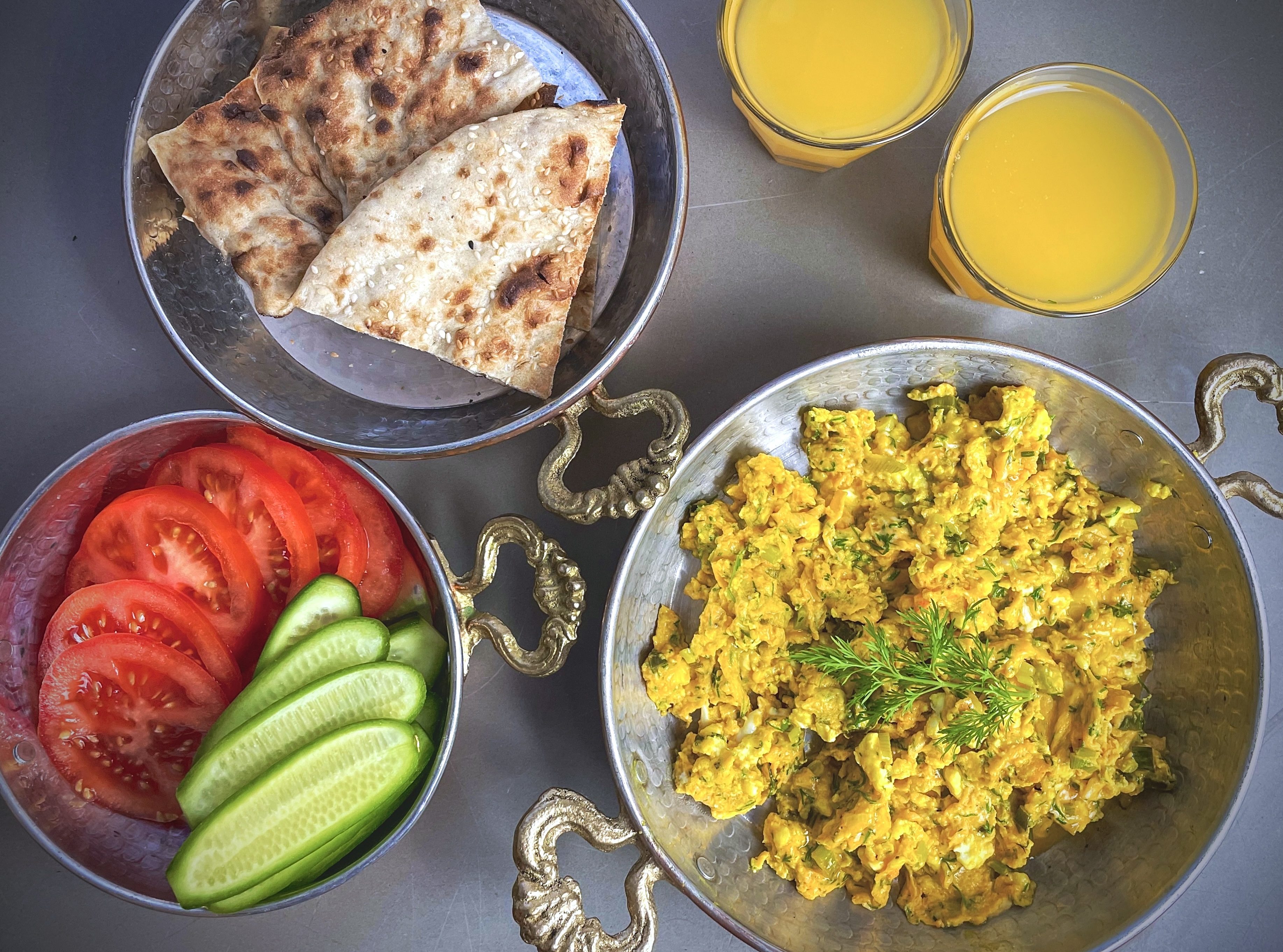

Panir Bereshteh is a delicately flavoured old recipe from Gilan Province, in northern Iran, which lies along the Caspian Sea bordering Russia. Feta is cooked with spring onions, garlic and turmeric before eggs are folded in. The name of the dish translated means ‘crispy cheese’ (Panir – cheese, and Bereshteh – crispy), but the actual dish is not crispy as the cheese melts to a creamy sauce while cooking, before the eggs are added.
Gilan is lush and green with many delicious dishes originating from the province, particularly vegetarian ones, namely Mirza Ghasemi (smoked aubergines and eggs) and Baghali Ghatogh (eggs with broad beans and dill).
This recipe is a great addition to your breakfast or brunch catalogue of recipes with the dill and feta resulting in fresh and light flavours. Serve with flatbread and a side of smoked salmon. For a veggie option, serve with tomatoes and cucumbers as pictured.

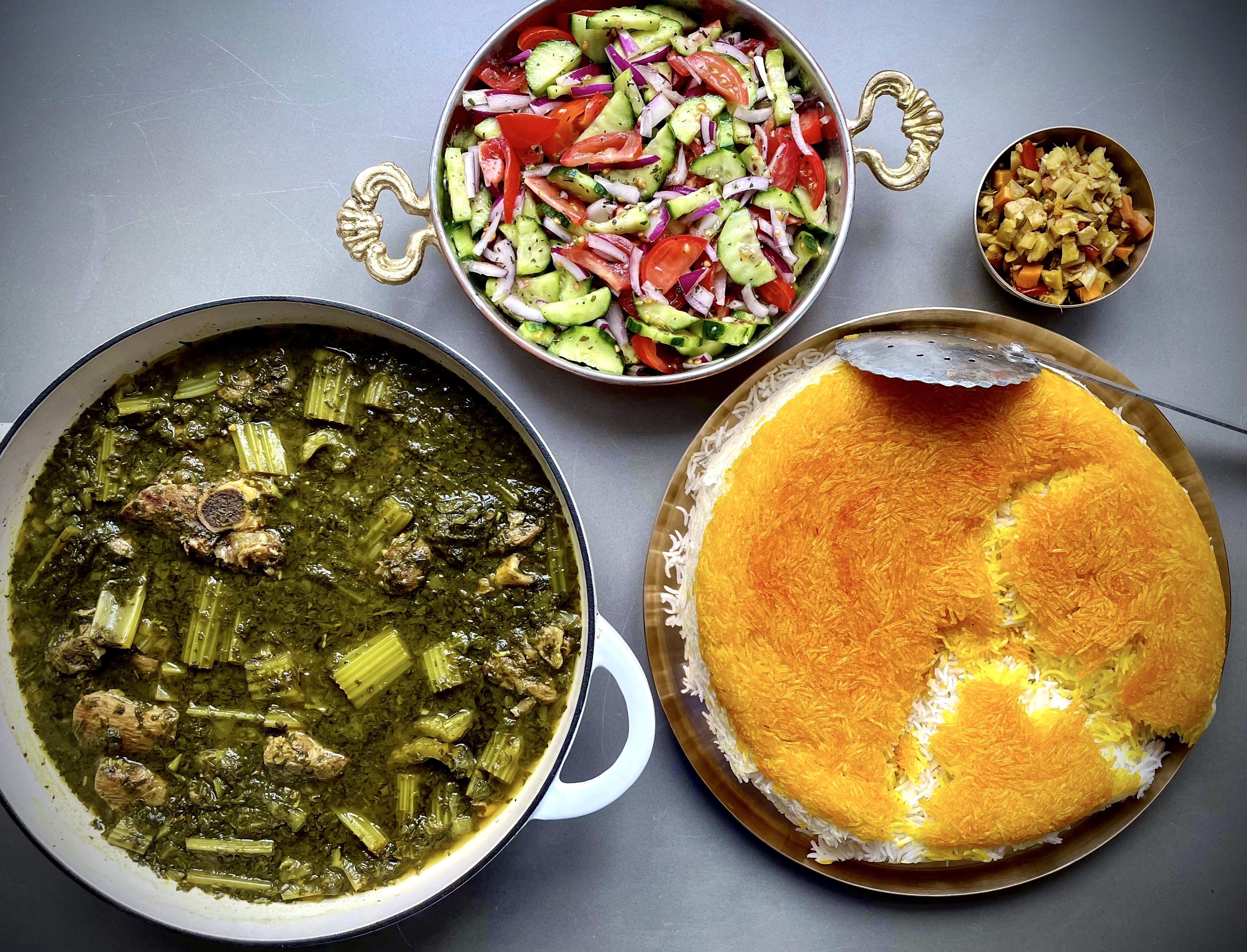

Winter is the season of stews and Khoresh Karafs is a lovely introduction if you are new to Persian cuisine. Persian stews are relatively low maintenance to cook. They just need time to cook and for the flavours to fall into place.
Khoresh Karafs is a Persian stew made with lamb, celery and fresh herbs (mint and parsley). ‘Karafs’ translated from Persian is ‘celery.’ And ‘Khoresh’ means ‘stew.’
We have two versions of Khoresh Karafs. The first one, the subject of this recipe and the better known version, is cooked with herbs. The second one is cooked with tomatoes and usually chicken. We refer to them by their colour: Khoresh Karafs-e-Sabz (‘sabz’ means green in Farsi); and Khoresh Karafs-e-Ghermez (‘ghermez’ means red in Farsi).
The ingredients for this khoresh (stew) are simple and easy to source with most items available at your local supermarket.
As with all Persian stews, the flavour continues to mature and intensify if you leave it for a day before you reheat and serve. This is, therefore, a dish you can make on a Sunday evening and tuck into later in the week reducing the time spent in the kitchen and washing up afterwards. Serve it with Persian rice – Chelow and a lime dressed chopped salad like Salad Shirazi.
Store in an airtight container in the fridge up to 3 days. Khoresh Karafs can also be frozen up to 4 months. Defrost thoroughly before reheating. Gently reheat khoresh in a saucepan or in a microwave.


Chelow is the name given to the white fluffy grains of rice either served with our kebabs or khoresh (stews) in Iranian cuisine. We also have Kateh, which refers to our version of easy-cook sticky rice, and polo, which refers to our rice cooked with vegetables, herbs and/or meat (similar to the Asian biryani).
Polo follows the same cooking procedure as chelow but has the added stage of preparing and cooking the ingredients to be mixed in to the rice. Kateh is simple as you boil and steam the rice without draining the water by letting it evaporate in the saucepan. Kateh tends to be reserved for family weekday meals.
The common feature in the various Persian rice options is that they all yield the crispy rice, which forms at the bottom of the cooking pot, called ‘Tahdig’. Tahdig literally translated means ‘bottom of the pot’ and is the most cherished part of our meals. I don’t think I have ever met someone who dislikes tahdig!
Although kateh is the easiest way of cooking Persian-style rice it does not yield a tahdig as superior as chelow or polo. Therefore you are rewarded for going the extra mile with the slightly more complicated way of cooking rice.
To achieve the perfect fluffy rice and golden tahdig is a commitment. Despite this, even the veteran chelow and tahdig cooker sometimes has an off day with rice coming out a bit mushy and the tahdig burnt. So don’t be hard on yourself if you commit to this journey and it takes a while to master it. 

Now while chelow has a standard set of preparation and cooking steps, tahdig has a number of different options available. The most common are rice, potato or flatbread options.
As with the evolution of many cuisines, experiments have been undertaken to explore new ways of reinventing a classic. In the case of tahdig people have experimented with ingredients to see if they can create a new type of tahdig as good as the originals. I’ve seen tahdigs made with lettuce, fish and chicken.
Chelow has a 6-step-process to follow, summarised below:
The recipe below sets out steps to serve the chelow and tahdig as a cake-style, tahdig encased rice as seen in the first set of pictures above.
For larger quantities, once the rice has cooked, I recommend spooning the rice out and serving it on one plate and then serving your tahdig separately on another dish. The latter is usually garnished with saffron coloured rice sprinkled on top (see picture). In my family we use a little rose water when blooming the saffron for the rice garnish as it adds a delicate floral note to the chelow, so if you want to present your rice this way then it is worth getting your hands on some rose water from your local Middle-Eastern food shop.
Simply mix a little cooked rice with saffron bloomed in a little water and rose water until it takes on a golden hue. Then sprinkle the saffron rice on top of the plain white rice and then serve.



Eshkeneh is a soup made with the primary ingredients of onion, potato, fenugreek, turmeric and egg. There are many variations of the recipe for Eshkeneh. If you have tried it before, you may be more familiar with the version that results in a golden soup with flecks of green from the fenugreek leaves. One of the many variations is made with the addition of tomatoes and this is the recipe I have shared below.
Eshkeneh originates from the Khorasan region of Iran – the east side. My mother and her family are from Mashhad, which is sometimes referred to as the ‘capital of Khorasan’, so this soup was a regular feature in my childhood.
Onions and potato are cooked with fresh and dried aromatics in a broth made with tomatoes and tomato purée. Eggs are added to make an egg-drop soup and a lemon and chive oil is drizzled over before serving.


If you have eaten at a Persian restaurant, then you will be familiar with Kabab Koobideh. The long metal skewers of minced lamb cooked to juicy perfection over a charcoal flame. Kabab Tabei is the easy version, cooked in a pan with no skewers required, and accompanied with a side of roasted tomatoes.
With the exception of saffron, the ingredients should be easy to source from your local supermarket.
Saffron can be found in most supermarkets nowadays. Remember to always grind the saffron strands to a fine powder after purchase because it makes the saffron go further. Bloom the amount of ground saffron directed in this recipe in water before adding to the Kabab Tabei mixture.
Serve with Kateh or Chelo (Persian rice) and Salad Shirazi as pictured. They can also be eaten with flatbreads, salad, chilli and garlic sauce with a side of chips as part of a fake-away style meal!
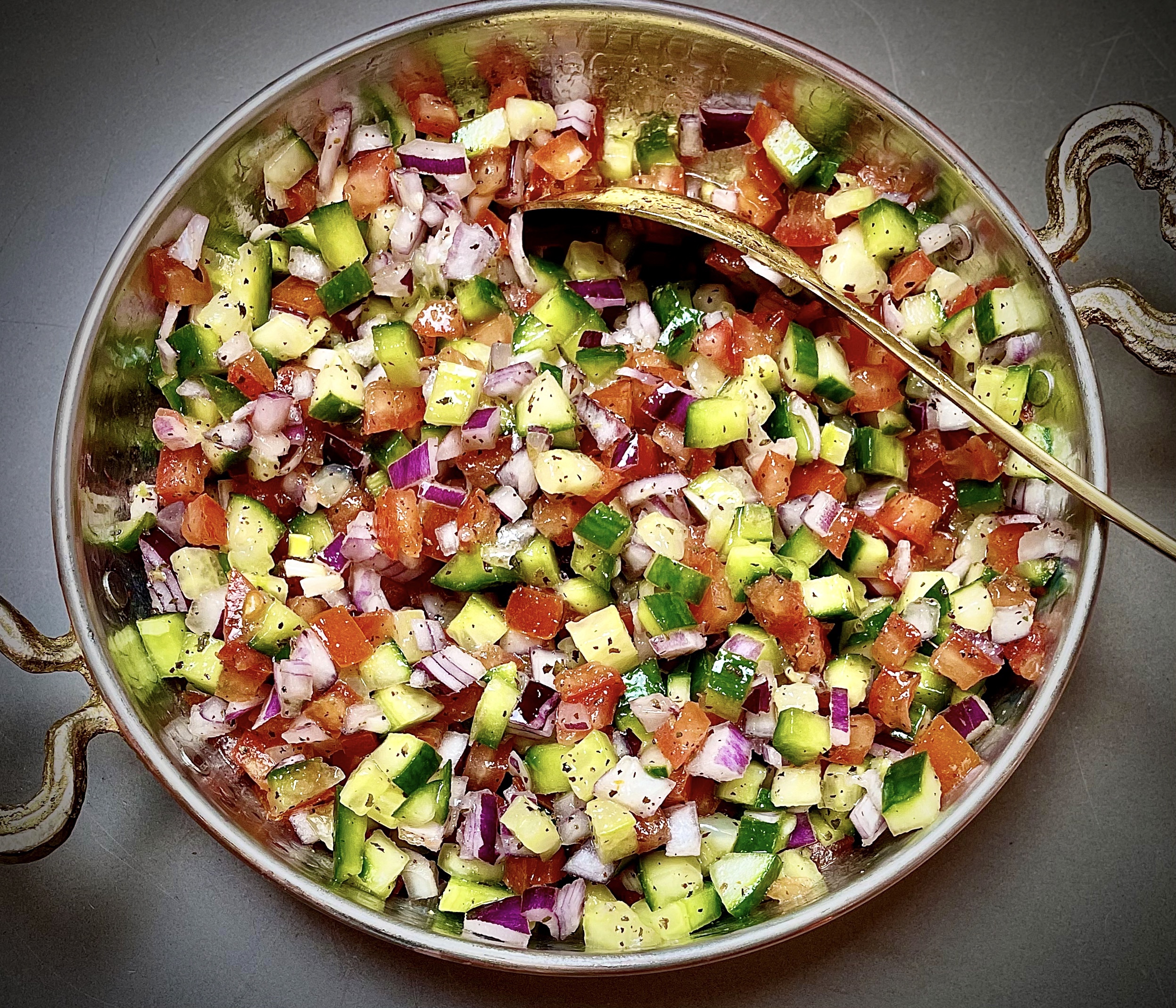

As the name gives away, Salad Shirazi originates from Shiraz, which is located in the South West of Iran. The reason it is called the National Salad of Iran is because it is our only salad recipe! It is similar to the Indian Kachumber and Israeli chopped salads.
Use fresh and high quality ingredients to get maximum flavour from your Salad Shirazi.
Scrape some of the the seeds out of both the cucumber and the tomatoes before dicing the salad ingredients. Although you want a juicy salad, you don’t want a water-logged one. Don’t be too obsessive about seed removal because the salad is meant to be juicy. You want to have some delicious dressing to spoon over the other elements on your plate.
Serve it as a side salad with all Persian mains from khoresh to kebabs. Here are some suggestions.
This salad can be eaten with any cuisine so no need to limit it to a side salad for Persian mains only.
Keep in an airtight container in the fridge and it will last up to 2 days.
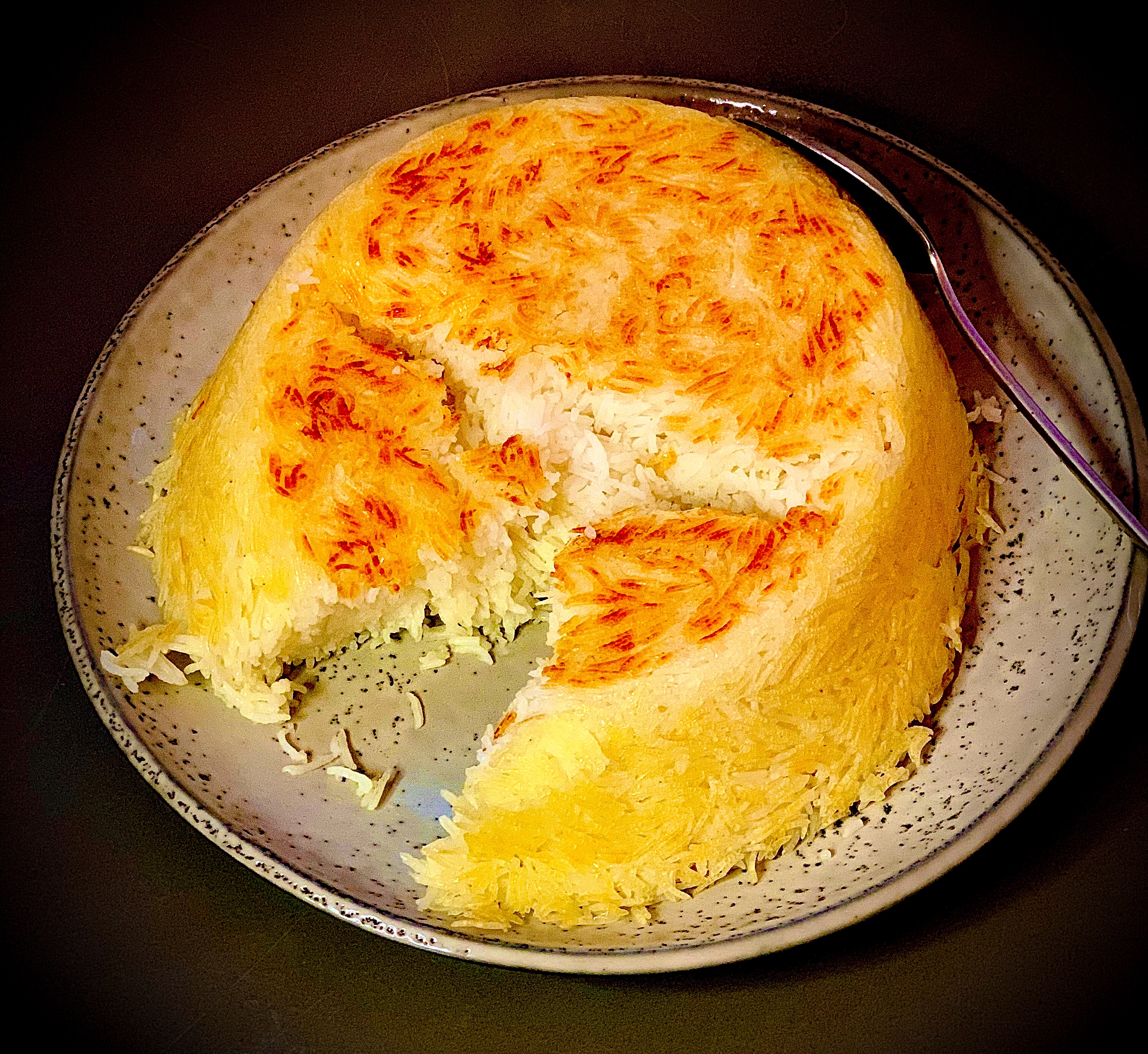
Create Persian rice with Tahdig using a simple one-step cooking process. An easy skill to master before you move to cooking Persian rice the expert way!
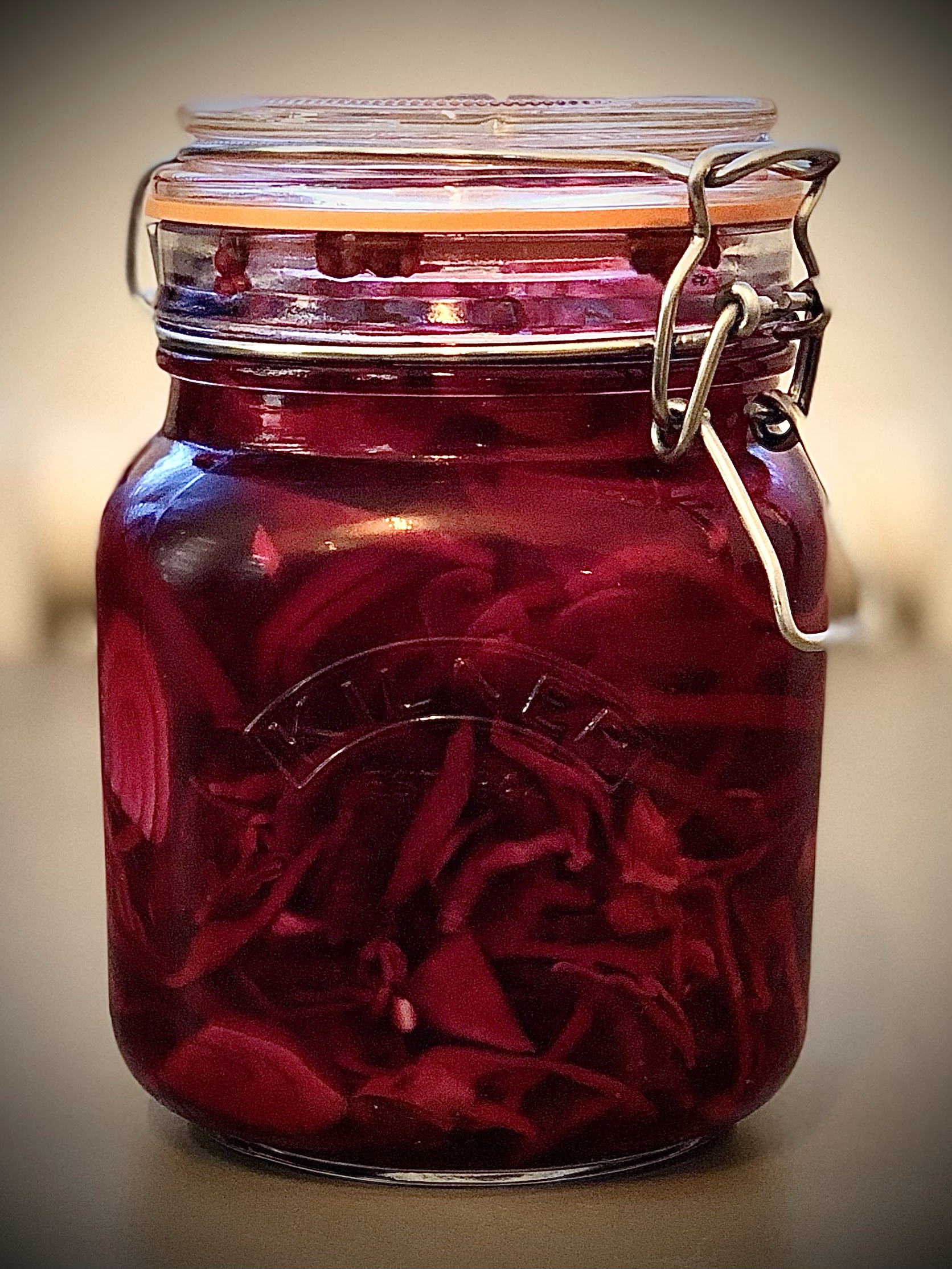

Torshi is derived from the word ‘Torsh’ in Farsi, which means sour. Torshi is used to describe vegetables pickled in vinegar. They are often eaten as accompaniments to dishes and / or aperitifs. On a Persian sofreh (spread) you will always find some Torshi.
The sour taste of the pickles perfectly complements many of our dishes, particularly those containing lamb, as it brings a balance to the richness of the flavours.
Thinly slice red cabbage and red onion. Place in a pickling jar (I am a fan of kilner jars) with coriander seeds. Dissolve the sugar and salt in white vinegar and pour into the jar. Leave for a minimum of 5 days to pickle. It is as simple as that!
‘Soorati’ means pink in Farsi and the pickle has been given this name as the resulting colour is a vibrant pink. A very versatile pickle suiting many cuisines, including Indian and Asian style dishes.
This pickle is delicious with so many dishes. Add to fried egg sandwiches, eat with kebab, burgers and wraps such as my sticky pomegranate chicken wraps. A perfect side to noodles too!
You may be left with some pickling liquid once the pickles are finished. Use it as a basis for a salad dressing. Just add olive oil and adjust with other flavourings such as a bit of lime juice and / or honey.

A simple one-pan spinach and egg breakfast dish. Garlicky and nutrient dense, serve this delicious dish with your favourite type of bread and Greek yoghurt.